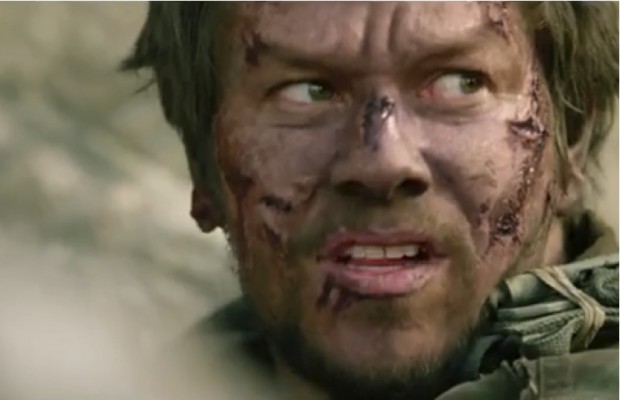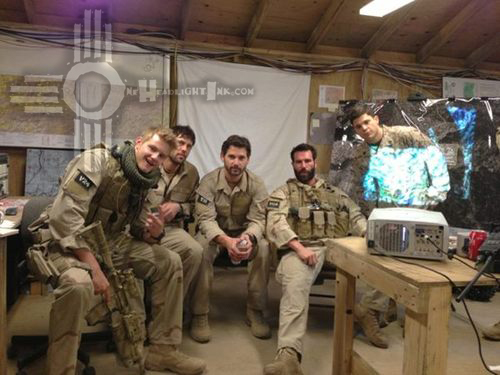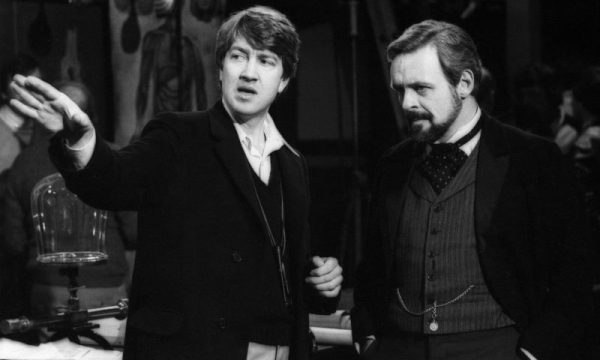 On paper, “Lone Survivor” looks every bit a high concept, fictional action movie. A group of chiseled Navy SEALs are dropped behind enemy lines in Afghanistan with one objective: kill a high ranking Taliban leader. One thing leads to another, and soon the soldiers find themselves massively outmanned, outgunned, and all but left for dead in enemy territory. Sticking to their proud, patriotic duties as American combat fighters, the team never gives up hope or courage under pressure. What makes this scenario even more powerful, however, is that it’s a true story. Based on the failed Operation Red Wings on June 28, 2005, this tragic drama is a brutal reminder that not every battle is won during a war. Director Peter Berg’s (Battleship) latest offers up plenty of both. The result is gripping, moving, and incredibly haunting.
On paper, “Lone Survivor” looks every bit a high concept, fictional action movie. A group of chiseled Navy SEALs are dropped behind enemy lines in Afghanistan with one objective: kill a high ranking Taliban leader. One thing leads to another, and soon the soldiers find themselves massively outmanned, outgunned, and all but left for dead in enemy territory. Sticking to their proud, patriotic duties as American combat fighters, the team never gives up hope or courage under pressure. What makes this scenario even more powerful, however, is that it’s a true story. Based on the failed Operation Red Wings on June 28, 2005, this tragic drama is a brutal reminder that not every battle is won during a war. Director Peter Berg’s (Battleship) latest offers up plenty of both. The result is gripping, moving, and incredibly haunting.
It doesn’t come as a major spoiler that most of the heroes the audience is introduced to at the onset of the film won’t survive the violence as the movie progresses. This fact is written into the title of the picture, which was adapted by Berg from Marcus Luttrell’s New York Times Bestseller by the same name. Luttrell’s account chronicles his involvement as part of a four-man task force with the mission to covertly track down a Taliban warlord in the remote, rugged Kunar province. But Operation Red Wings is quickly compromised and the SEALs (played by Mark Wahlberg, Taylor Kitsch, Emile Hirsch and Ben Foster) find themselves in a deadly firefight against Taliban fighters.
themselves in a deadly firefight against Taliban fighters.
Even though Wahlberg plays Marcus Luttrell, the one who becomes the “lone survivor,” he is definitely not the protagonist of the film. Throughout the picture, Berg stresses the idea of teamwork and brotherhood within the ranks of the Navy SEALs, and as such, every character is given essentially equal screen time. Berg takes the time to allow the audience to get to know Michael (Taylor Kitsch), Danny (Emile Hirsch), Matt (Ben Foster) and Marcus (Wahlberg) through extensive character development at a nearby US army base before shipping them off to battle. While there, we come to learn that Michael is the squad captain. He’s the decision man, and if this were a prototypical Hollywood action movie, he’d probably be the man riding off into the sunset as the end credits roll. It is only because this is a true story that Marcus becomes the principal character as the story comes to a close. And when it does, no one rides gallantly into the sunset.
 When the epic gunfight finally does begin, about halfway through the film, it is captured by Cinematographer Tobias Schliessler as if it were a relentless overture of blood, bullets, and grit. For almost an hour, and without any over-arching musical score, the audience is given a front row seat to the closest thing to experiencing actual war the average civilian will ever get. The combat is definitely graphic. Heads explode, bones crunch, and bodies swell as the result of blunt force trauma. Yet, all the while, Berg maintains a certain level of composure in staging this showdown. There are a few frantic moments with shaky camera angles, but for the most part, the director seems just as calm under the circumstances as the American fighters he is recording.
When the epic gunfight finally does begin, about halfway through the film, it is captured by Cinematographer Tobias Schliessler as if it were a relentless overture of blood, bullets, and grit. For almost an hour, and without any over-arching musical score, the audience is given a front row seat to the closest thing to experiencing actual war the average civilian will ever get. The combat is definitely graphic. Heads explode, bones crunch, and bodies swell as the result of blunt force trauma. Yet, all the while, Berg maintains a certain level of composure in staging this showdown. There are a few frantic moments with shaky camera angles, but for the most part, the director seems just as calm under the circumstances as the American fighters he is recording.
In the beginning of the film, Berg shows real footage of the rigorous training process that is involved in developing the elite SEALs and their extreme bond with one another. They are essentially living, breathing superheroes. As this hyper violence continues, we watch as all of this training is put to the ultimate test. The will to survive burns bright in all four soldiers, and whereas they can end the life of an Afghani fighter with one shot to the face, they themselves require six…seven…eight bullets before they submit. While this could be cause for some critics to see the SEALs’ inability to die as a Hollywood trick, it is anything but. Berg introduces the concept that Navy SEALs are somehow super-human in comparison to other types of soldiers in the world. Their relentless valor is just the pay off.
As if watching CNN weren’t proof enough, “Lone Survivor” shows that war is absolutely hell. Yet, even as our heroes are pinned down against an entire army of enemies, there is something beautiful about Berg’s film. Shot in New Mexico, the state’s dynamic landscape, with its many tree-lined mountains and expansive deserts, is a beautiful stand in for Afghanistan. At the same time, even as blood oozes from their wounds, there is something intrinsically poetic about Marcus, Michael, Danny, and Matt. They are four soldiers operating at the peak of their killing abilities. Fueled by adrenaline, fear, and the will to survive, the actors that portray them on screen are breathtaking in their transformation.
something beautiful about Berg’s film. Shot in New Mexico, the state’s dynamic landscape, with its many tree-lined mountains and expansive deserts, is a beautiful stand in for Afghanistan. At the same time, even as blood oozes from their wounds, there is something intrinsically poetic about Marcus, Michael, Danny, and Matt. They are four soldiers operating at the peak of their killing abilities. Fueled by adrenaline, fear, and the will to survive, the actors that portray them on screen are breathtaking in their transformation.
“Lone Survivor” is just about as patriotic as singing the “Star-Spangled Banner.” With an overarching story perfect for action junkies, Berg’s film also has the ability to make even the manliest of men choke up with tears. All of the drama becomes even more gut-wrenching because everything depicted on screen actually happened to real people. These are the last moments of someone’s life, and as the end credits roll, we see the pictures of the real fallen soldiers cut down in battle. It’s a haunting finale, and one that defies the action genre norm.
After last year’s box office flop “Battleship,” Berg’s return to cinema is fantastic. Seeing this one in a theater is a must because it allows for the full bullet ricochet effect.
Rated R for strong bloody war violence and pervasive language
By David Morris
www.lonesurvivorfilm.com














